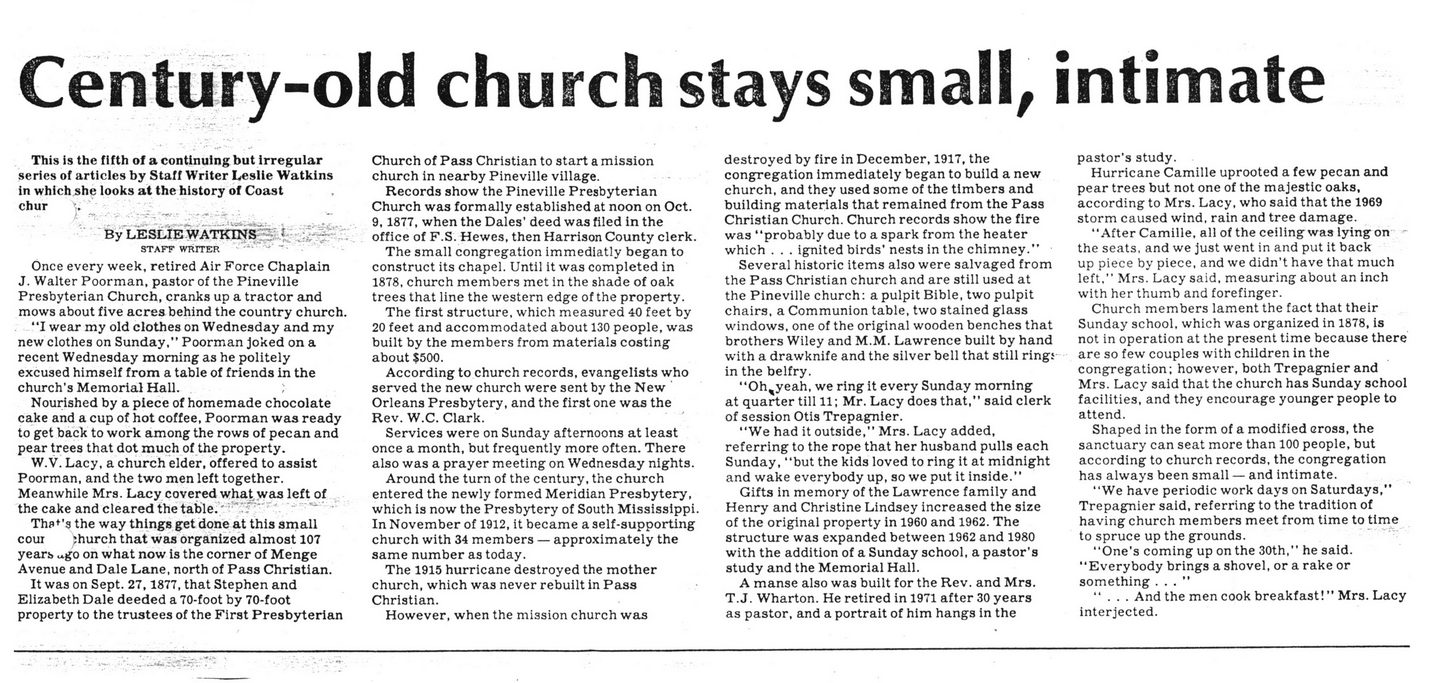This text was obtained via automated optical character recognition.
It has not been edited and may therefore contain several errors.
Century-old church stays small, intimate This is the fifth of a continuing but irregular series of articles by Staff Writer Leslie Watkins in which she looks at the history of Coast chur ' By LESLIE STAFF WRITER Once every week, retired Air Force Chaplain J. Walter Poorman, pastor of the Pineville Presbyterian Church, cranks up a tractor and mows about five acres behind the country church. "I wear my old clothes on Wednesday and my new clothes on Sunday,? Poorman joked on a recent Wednesday morning as he politely excused himself from a table of friends in the church?s Memorial Hall. ; Nourished by a piece of homemade chocolate cake and a cup of hot coffee, Poorman was ready to get back to work among the rows of pecan and pear trees that dot much of the property. W.V. Lacy, a church elder, offered to assist Poorman, and the two men left together. Meanwhile Mrs. Lacy covered what, was left of the cake and cleared the table. Tha*?s the way things get done at this small coui :hurch that was organized almost 107 years ^go on what now is the comer of Menge Avenue and Dale Lane, north of Pass Christian. It was on Sept. 27,1877, that Stephen and Elizabeth Dale deeded a 70-foot by 70-foot property to the trustees of the First Presbyterian Church of Pass Christian to start a mission church in nearby Pineville village. Records show the Pineville Presbyterian Church was formally established at noon on Oct. 9,1877, when the Dales? deed was filed in the office of F.S. Hewes, then Harrison County clerk. The small congregation immediatly began to construct its chapel. Until it was completed in 1878, church members met in the shade of oak trees that line the western edge of the property. The first structure, which measured 40 feet by 20 feet and accommodated about 130 people, was built by the members from materials costing about $500. According to church records, evangelists who served the new church were sent by the New Orleans Presbytery, and the first one was the Rev. W.C. Clark. Services were on Sunday afternoons at least once a month, but frequently more often. There also was a prayer meeting on Wednesday nights. Around the turn of the century, the church entered the newly formed Meridian Presbytery, which is now the Presbytery of South Mississippi. In November of 1912, it became a self-supporting church with 34 members ? approximately the same number as today. The 1915 hurricane destroyed the mother church, which was never rebuilt in Pass Christian. However, when the mission church was destroyed by fire in December, 1917, the congregation immediately began to build a new church, and they used some of the timbers and building materials that remained from the Pass Christian Church. Church records show the fire was ?probably due to a spark from the heater which . . . ignited birds' nests in the chimney.? Several historic items also were salvaged from the Pass Christian church and are still used at the Pineville church: a pulpit Bible, two pulpit chairs, a Communion table, two stained glass windows, one of the original wooden benches that brothers Wiley and M.M. Lawrence built by hand with a drawknife and the silver bell that still ring: in the belfry. ?Oh^yeah, we ring it every Sunday morning at quarter till 11; Mr. Lacy does that,? said clerk of session Otis Trepagnier. ?We had it outside," Mrs. Lacy added, referring to the rope that her husband pulls each Sunday, "but the kids loved to ring it at midnight and wake everybody up, so we put it inside." Gifts in memory of the Lawrence family and Henry and Christine Lindsey increased the size of the original property in 1960 and 1962. The structure was expanded between 1962 and 1980 with the addition of a Sunday school, a pastor?s study and the Memorial Hall. A manse also was built for the Rev. and Mrs. T. J. Wharton. He retired in 1971 after 30 years as pastor, and a portrait of him hangs in the pastor?s study. Hurricane Camille uprooted a few pecan and pear trees but not one of the majestic oaks, according to Mrs. Lacy, who said that the 1969 storm caused wind, rain and tree damage. "After Camille, all of the ceiling was lying on -the seats, and we just went in and put it back up piece by piece, and we didn?t have that much left," Mrs. Lacy said, measuring about an inch with her thumb and forefinger. Church members lament the fact that their Sunday school, which was organized in 1878, is not in operation at the present time because there are so few couples with children in the congregation; however, both Trepagnier and Mrs. Lacy said that the church has Sunday school facilities, and they encourage younger people to attend. Shaped in the form of a modified cross, the sanctuary can seat more than 100 people, but according to church records, the congregation has always been small ? and intimate. ?We have periodic work days on Saturdays,? Trepagnier said, referring to the tradition of having church members meet from time to time to spruce up the grounds. ?One?s coming up on the 30th,? he said. ?Everybody brings a shovel, or a rake or something ...? "... And the men cook breakfast!? Mrs. Lacy interjected.

First Presbyterian Church Newspaper-Article---Century-Old-Church-Stays-Small-Intimate